
HOW INSTITUTIONS TRADE AND HOW CAN WE SPOT THEIR TRADE LOCATIONS?
4 August 2024, 16:38
0
53
HOW INSTITUTIONS TRADE AND HOW CAN WE SPOT THEIR TRADE LOCATIONS?
Today, I will tell you something you have seen nowhere before. The knowledge would completely transform your trading and how you utilize expert advisors. With after some practice, you will see the most profitable trades come after the method I will tell you right now.
Basic Building Blocks:
Price moves with 4 types of orders:
1- Stop orders,
2- Limit orders,
3 -Stop loss orders,
4- Market orders.
The first 3 types of orders are not dynamic orders. I mean, they are sent to the system and wait there till they are fulfilled by market orders.
Market orders are the type orders operating with the current price. For example, If you want to buy EURUSD with the current price you send market orders to the system.
If there are no market orders, prices simply would not move at all.
Similarly, there are 2 types of players in the price charts:
1- Retail traders,
2- Institutions.
Now the tricky and the dirty point start: How Institutions Trade and The Importance of Liquidity Pools:
Institutions can not trade like retail traders. This is because when they send market orders with their huge capital, they clear all the ‘waiting static’ orders in the system and price skyrockets up or cracks down in a few minutes. This would create huge volatility in the system.
This huge volatility would take the attention of regulatory organizations which will result in a messing up with them. They definitely do not want this.
They need to trade by covering 1- their intentions and 2- not resulting in a huge volatility in market prices.
For this reason they need the liquidity pools where there is a big supply of orders from retail traders. As there is a big supply of orders, institutions can carry out by covering their trades.
Hmmmm, we are getting somewhere right?
How Retail Traders Are Fooled?
Institutions set up this game and make retail traders provide their orders to the system to create liquidity. Institutions are setting up the game (price chart) in such a manner that retail traders are going to think price will keep going or not going and provide liquidity to the market. But while they make retail traders think this way, institutions are either closing their positions(liquidate) or collecting orders for a reversal.
Unfortunately, the vast majority of retail traders are sacrificed in this game. Although governments are aware of these situations, they are simply silent and allow this process.
What makes retail traders sacrifice themselves in this game is the traditional trading mindset and as long as you can not get rid of this you will continue to be sacrificed.
How to Spot the Trade Locations Of Institutions?
There are several methods we can find clues on this. One of the methods we can chase institutional trade locations is the ‘divergences’. The divergences are showing these liquidity pools where institutions carry out their trades.
When there is a difference between the direction of an indicator and the price, we see a divergence. As an example, I provide the below graph from USDCAD price chart.
You will see on several occasions that when price is making higher highs, the indicator makes lower highs. This is the place where we track institutional orders. Did you notice the reversals followed by the divergences?

Below you will also see several other divergences on EURUSD price chart. I also mark my closed trades followed by the divergence.
Here the profit is about $2.6k
Summary
In this short article, I have shown you a method for tracking the trade locations of institutions. There are also several other methods but I found the divergence approach is a reliable one. Like every concept in trading, this also does not hold every time.
Particularly, if there is a news, institutions do not need to worry about regulators and push the price strongly and remember this time they also sweep 1- stop orders above new highs or lows, 2- limit orders above tops or bottoms and 3- stop loss orders at higher or lower locations.
With some practice, you will see the most profitable trades come after such divergences.
Good luck and let mw know if you have further question.




